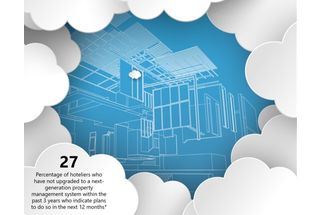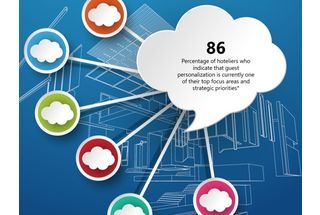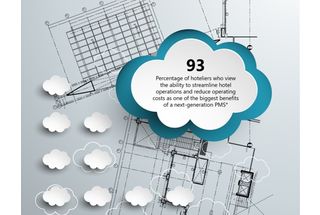Built for the Cloud: A Blueprint for Hotel Technology Success




Note: The following is an excerpt from the new Starfleet Research report "Built for the Cloud: A Blueprint for Hotel Technology Success" (now available for complimentary access):
When it comes to hotel operations, no times are more interesting than these, to borrow that oft-quoted Chinese curse (or blessing, depending on your perspective): "May you live in interesting times."
Competition in many lodging markets is more intense than ever. Guest expectations, particularly with respect to anytime, anywhere mobile engagement and information access, are through the roof.
Hoteliers face a variety of other challenges, too, from rising labor costs and onerous OTA commissions to competitive threats from disruptive business innovation, home-sharing models being an obvious example. In short, the world is changing fast and hoteliers cannot afford to sit back and relax.
Perhaps the biggest challenge — and, also, the biggest opportunity — relates to the increasingly large role that technologies play in enhancing the quality of the guest experience. Foremost amongst these technologies are next-generation cloud property management systems (PMS). Most hoteliers who haven't already upgraded to a cloud platform plan to do so shortly, if only to keep pace with others in the same competitive set.
And while even the most advanced cloud PMS cannot address all the challenges hoteliers face, it can address many of them while setting the stage for continuous performance improvement.
The allure of the cloud is undeniable. Oft-cited benefits include elimination of on-site server hardware (and the day-to-day maintenance that goes with it) and software that is continually updated with the latest features and functionality, without the need to purchase and install each new release.
Also, with a cloud solution it becomes much easier to integrate data from different sources and integrate other technologies. What's more, a cloud solution usually allows for nimble technology stacks. If part of the integrated system becomes obsolete or fails, for whatever reason, new software can be readily plugged in to replace it.
Hotels have come to embrace the cloud somewhat belatedly compared to other industries. Some of the "blame" for the lagging cloud movement lands squarely with the hotel brands themselves. On-property legacy system solutions, including proprietary technology stacks built by internal IT departments for exorbitant sums of money, have, ironically, become a hinderance to achieving optimal hotel performance.
Having underestimated the need to migrate their product road map to the cloud, and hamstrung with legacy installations across thousands of customers, some major solution providers are also to "blame."
Upgrading to the Cloud
As if to make up for lost time, hoteliers are now upgrading to next-generation cloud solutions in record numbers. Today nobody questions the cost savings that come from streamlining operations across all hotel functions and all parts of the property (or properties).
By now, everyone can agree that having a cloud PMS is a prerequisite to improving guest satisfaction, speeding guest services — from check-in and housekeeping to concierge and maintenance response times — and enabling guest-facing interfaces, including self-service options. Hoteliers know that only by harnessing the power of data and analytics — core features of a cloud PMS — can they present guests with relevant and personalized offers, messages and treatments, further engendering satisfaction and loyalty.
But buyer beware: Not all cloud solutions billed as "next-generation" are worthy of that description. For that matter, not all cloud solutions are even truly cloud solutions. Fact is, some legacy on-premise solution providers, eager to jump on the cloud PMS bandwagon, engaged in what is commonly known as "cloud-washing."
Even today, solutions billed as cloud-based may not, in fact, be true cloud solutions. It is important to understand the difference between a "true cloud solution" and a "fake cloud solution."
Whereas the latter is built on software originally designed to run on-premise, a true cloud solution is built from the ground up, coded to perform as a fully-hosted cloud solution and optimized for tablet and mobile use. The solution provider hosts the solution across hundreds of servers and with multiple levels of data redundancy in a multi-tenant "pure cloud' environment. Customers typically access the same solution via an internet browser, allowing for instantaneous product upgrades.
A customization platform maintains property-specific changes following these software upgrades so that customers can gain immediate access to the latest functionality without having to re-implement custom changes and integrations.
"True Cloud" Versus "Fake Cloud"
Cloud-based solutions are not, in fact, always based in the cloud. Some of the dominant PMS legacy solutions that are currently in place across Europe, North America and Asia have been merely upgraded with a web front-end interface. The interface provides access via an internet browser on a computer, tablet or mobile device to the back-end software, which remains hosted on a local, on premise server.
This type of cloud-based hospitality software, in which certain critical elements continue to reside on-premise — including, in many cases, the actual database housing the guest data — are known as hybrid cloud solutions. A web-native "true cloud" solution, on the other hand, is hosted on shared application servers in a public cloud environment and has the advantage of being more agile, flexible and open to multi-tenancy.
Another advantage relates to software release updates. With a true cloud solution, these upgrades are more seamlessly and frequently deployed and also included as part of the cost.
With respect to system upgrades, the shift from on-premise installation to cloud-based deployment have caused hoteliers to pay close attention to service level agreements and up-time guarantees. This is no surprise given that the PMS handles virtually all operations, including guest-facing service functions. Hotels that experience technology performance issues generally pay a dear price.
In the past, these issues have tended to arise most often during, or immediately following, system upgrades of on-premise, client-server software. Regardless of how much time and effort may have gone into quality assurance testing, new releases of hospitality applications with monolithic feature-laden code were bound to have performance issues. The problem was oftentimes related to the difficulty of simulating a hotel's customized software configuration, including the specific data streams that flowed into the PMS.
To help reduce potential performance issues related to system upgrades, solution providers would commonly implement user acceptance testing processes. This meant creating a copy of the production database and installing an advance copy of the new software release on the hotel's servers. Hotel staff would rigorously test the new system, trying to identify defects and reporting any bugs or performance shortcomings.
A benefit to this approach, in addition to reducing the risk of calamity, was that hotel staff could familiarize themselves with new interface as well as features and functionality prior to going live. Software fixes would be either installed as patches or incorporated into a new release, which, typically, would then be reinstalled and retested. The trial run process continued until all issues were resolved and the software was deemed to be relatively free of defects.
The software upgrade process for a true cloud PMS is very different. In sharp contrast to the process involving legacy systems and even, to a lesser degree, hybrid cloud solutions, this process tends to be largely hassle- and worry-free for hoteliers, who, in past, were often held partially responsible for any performance hiccups. With single-version development, all hotel customers are upgraded simultaneously, putting the onus on the solution provider to ensure that the software is delivered with unfaltering quality and performs in an error-free manner.
Multi-tenancy, storage arrays and the same data center hardware generally means that all hotel customers are in the same boat when it comes to technical performance issues. If a problem arises, the same problem will usually have already affected other hotel operations. The problem will likely have already reported it and the solution provider will already be working to resolve it. Single-version development and deployment benefits everyone.
Due to lower deployment overhead, new releases tend to be smaller and scope and more frequent. In general, there are no long downtimes for upgrades and maintenance windows are shorter. New features designed to meet current business challenges, and incremental improvements to existing functionalities, tend to be rolled out on an ongoing basis as they become available.
Note: This article is an excerpt from the new Starfleet Research report "Built for the Cloud: A Blueprint for Hotel Technology Success" (now available for complimentary access).
About Starfleet Research
Every year, Starfleet Research, the IT market research arm of Starfleet Media, benchmarks best practices in technology-enabled business initiatives across thousands of hotels and resorts around the world. Starfleet Media also now publishes Hotel Technology News and Restaurant Technology News. To learn more, and to access the latest Smart Decision Guides, co-branded eBooks and other resources, please visit starfleetresearch.com
Alisha Levin
Marketing Manager
Starfleet Research